Brian J. Dunn
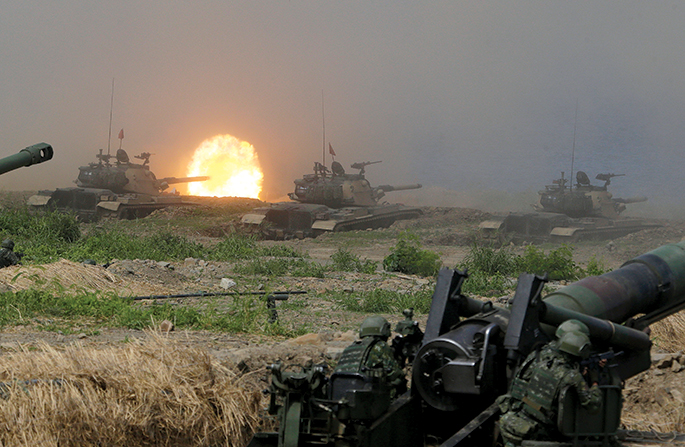
China has a longstanding claim to Taiwan that “persistently remains the PLA’s [People’s Liberation Army] main ‘strategic direction.’”1 Now, however, China’s rising military power has made this core interest an objective that is within its reach.2 China would prefer to avoid outside intervention in this endeavor, but what would it have to achieve in order to capture and annex Taiwan without drawing in an American-led coalition?
Too much effort is spent looking at China’s insufficient amphibious lift assets, whether Taiwan can resist until the American cavalry arrives, or whether Taiwanese asymmetric strategies could deter China by raising PLA casualties to unacceptable levels. What if China is willing to pay the price to invade? What if China can achieve key objectives within America’s reaction time? And what if China doesn’t share the assumptions about what it needs to take an army across the Taiwan Strait? A U.S. Army corps will be key to thwarting China’s ambitions regarding Taiwan.
To defeat Taiwan and avoid war with America, all China needs to do is get ashore in force and impose a cease-fire prior to significant American intervention. Once that is achieved, a future phase two of overrunning or simply overawing Taiwan into submission can take place at a time of China’s choosing after reinforcing and supplying its occupied Taiwan territory.
The only method of preventing China from successfully annexing Taiwan is to reject calls for a cease-fire, contain Chinese bridgeheads and airheads into as small a perimeter as possible, and then drive the invaders into the sea. Contrary to the limited Army supporting role envisioned in the Pacific, an Army corps will be indispensable and must be fully incorporated into U.S. Indo-Pacific Command (INDOPACOM) Taiwan contingency plans.3
Balance of Local Forces
In the past, the balance of forces for the Chinese and Taiwanese militaries was once irrelevant because the U.S. Navy dominated the Taiwan Strait. It is only in the last quarter century that China’s increasingly sophisticated military with a full array of anti-access/area denial (A2/AD) weapons has made it considerably more difficult for America to stop a potential Chinese invasion with its forward deployed fleet in the western Pacific. The scale of China’s naval power growth is illustrated by China’s view of American naval power during the 1996 Taiwan Strait Crisis. The deployment of two American aircraft carriers to the Taiwan region was seen as not a mere signal but an “operationally effective force” that “reminded the PLA of American command of the seas in East Asia, and that the [PLA Navy’s] ability to carry out missions opposed by the United States is nil, unless a way is found to nullify American sea power.”4
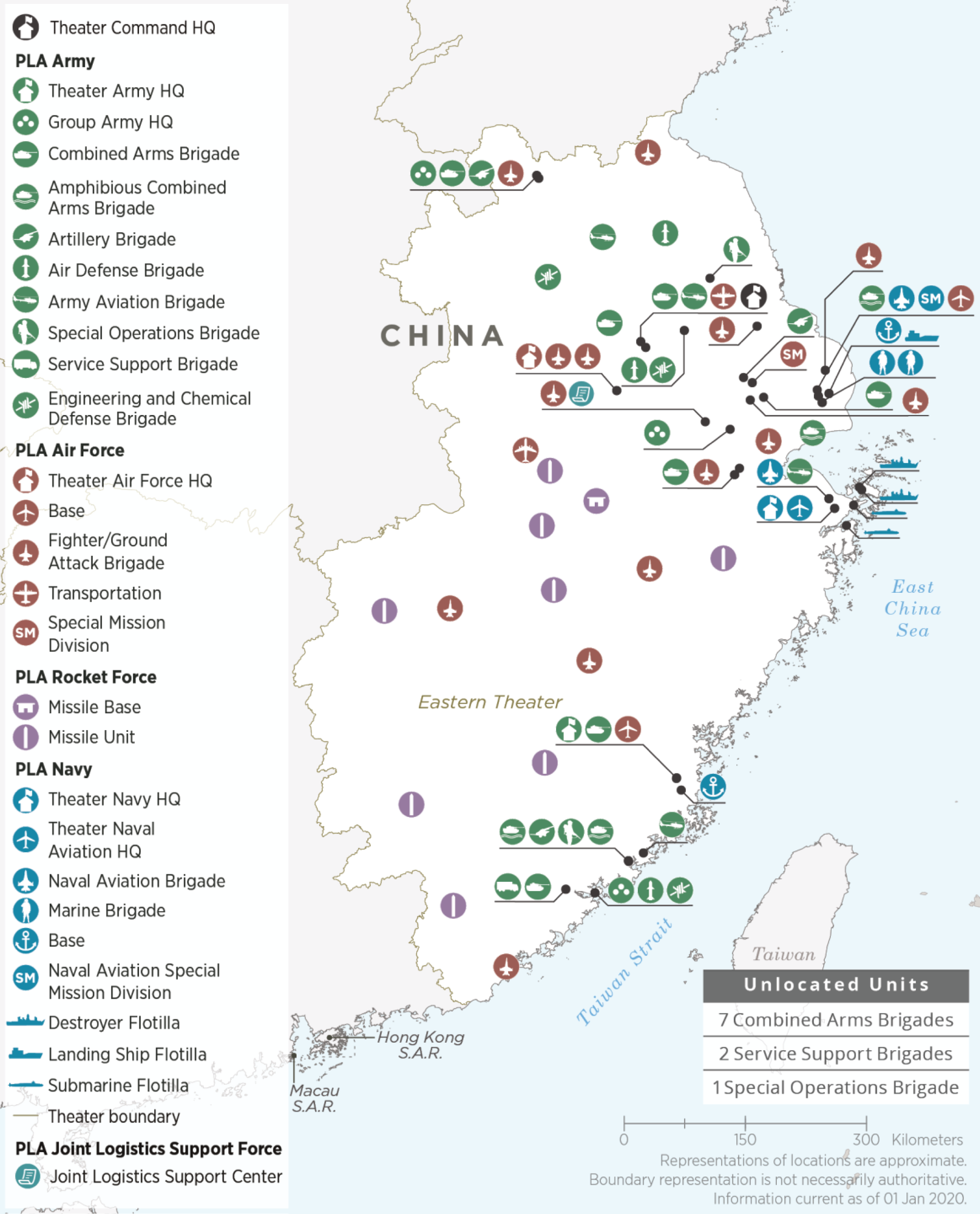
China’s Eastern Theater (Figure from the Office of the Secretary of Defense, Annual Report to Congress: Military and Security Developments Involving the People’s Republic of China 2020,
Chinese A2/AD capabilities are now strong enough to make the U.S. Navy wary of approaching China. China’s military strength compels the Navy to call on ground forces to help gain control of the seas near China. The U.S. Marine Corps has declared mobile antiship missiles its highest modernization priority in order to be “an arm of naval power.”5 The Army views the Pacific’s dominant sea domain as requiring very different artillery brigade attributes to operate on small islands in support of the Navy.6
Taiwan has significant forces to attack Chinese invasion forces at sea, in the air, and on the ground. But as the balance of forces tilts toward China, Taiwan is stressing an asymmetric response including “information and electronic warfare, high-speed stealth vessels, shore-based mobile missiles, rapid mining and minesweeping, unmanned aerial systems, and critical infrastructure protection” to resist a Chinese invasion.7 Taiwan is also developing an all-volunteer military that includes a reduction in active-duty strength. However, a shortage of volunteers has hampered Taiwan’s ability to reach its manning goal of 90 percent of end strength, which is authorized at just 188,000.8
Taiwan fields 140,000 ground-force personnel in three army groups containing a total of three mechanized brigades, six motorized infantry brigades, four armor brigades, four air assault/aviation brigades, three artillery brigades, and two marine brigades.9 Taiwan’s air and naval assets are outnumbered, lack their former technological superiority, and lack the capability to reinforce or replace losses as do the Chinese forces closest to Taiwan.10 Given that Taiwan’s ability to defeat the PLA in and over the Taiwan Strait has eroded, I assume that China will gain sufficient air and naval superiority in the Taiwan Strait.
The U.S. Department of Defense (DOD) assesses that the PLA “continues to prepare for contingencies in the Taiwan Strait to deter, and if necessary, compel Taiwan to abandon moves toward independence. The PLA also is likely preparing for a contingency to unify Taiwan with the mainland by force, while simultaneously deterring, delaying, or denying any third-party intervention on Taiwan’s behalf.”11
The reorganization of the PLA Army (PLAA) into combined arms brigades, the expansion of army aviation, the creation of other combat support elements, improved air assault, and more close air support options have had the result of “improving and increasing its options for a Taiwan invasion.”12 The PLA Navy (PLAN), PLA Air Force, and PLA Rocket Force; the PLA’s Strategic Support Force (space and cyberspace operations); and its Joint Logistics Support Force have all increased capabilities to support an invasion.13 China’s Eastern Theater Command would likely have operational control of forces in combat around Taiwan (see map).14
The DOD includes PLA forces in China’s eastern and southern theaters as available for Taiwan contingencies. China has in those theaters 408,000 ground force personnel in five army groups credited with thirty PLAA combined arms brigades (five with amphibious roles), five air assault/aviation brigades, and five artillery brigades, plus six airborne and four marine brigades).15 China’s naval and air power are overwhelming, and it has a significant ballistic and cruise missile inventory that can destroy and disrupt Taiwan’s assets at the onset of war.16 The rest of the PLA could reinforce or replace combat losses. The Chinese marines would be available for an invasion of Taiwan. However, they may not be more than a spearhead where needed given their traditional focus on the South China Sea and recent orientation to areas farther afield, including inland, as an expeditionary force as much as an amphibious force.17
Getting Ashore
Efforts to improve capabilities to invade Taiwan across all elements of the PLA are enabled by overwhelming defense spending, “much of it focused on developing the capability to unify Taiwan with the mainland by force,” according to the DOD; yet the DOD seemingly minimizes the likelihood of a successful invasion.18
Publicly available Chinese writings describe different operational concepts for an amphibious invasion of Taiwan. … The objective would be to break through or circumvent shore defenses, establish and build a beachhead, transport personnel and materiel to designated landing sites in the north or south of Taiwan’s western coastline, and launch attacks to seize and occupy key targets or the entire island.
Large-scale amphibious invasion is one of the most complicated and difficult military operations. Success depends upon air and maritime superiority, the rapid buildup and sustainment of supplies onshore, and uninterrupted support. An attempt to invade Taiwan would likely strain China’s armed forces and invite international intervention. These stresses, combined with China’s combat force attrition and the complexity of urban warfare and counterinsurgency, even assuming a successful landing and breakout, make an amphibious invasion of Taiwan a significant political and military risk.19
The broad increase in Chinese military capabilities and China’s great interest in annexing Taiwan by force if necessary is seemingly belied by the lack of PLAN amphibious capabilities or a marine force anywhere nearly as large and sophisticated as the U.S. Navy-Marine Corps team. The DOD notes the lack of PLAN landing ships, “suggesting a direct beach-assault operation requiring extensive lift is less likely in planning.”20 Further, Chinese amphibious capabilities are not exercised at levels above battalion, notwithstanding the reorganization and reequipping of amphibious and airborne forces.
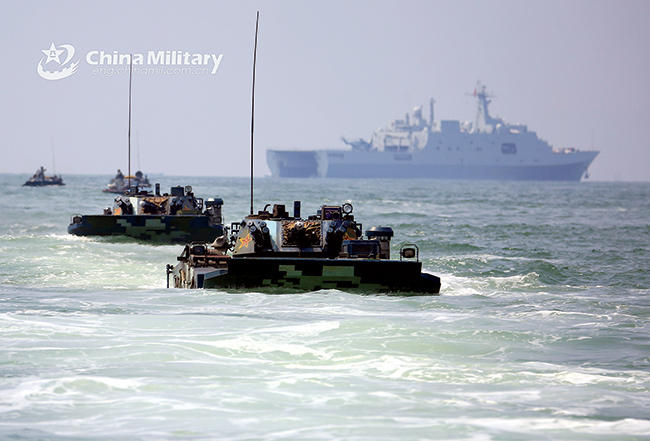
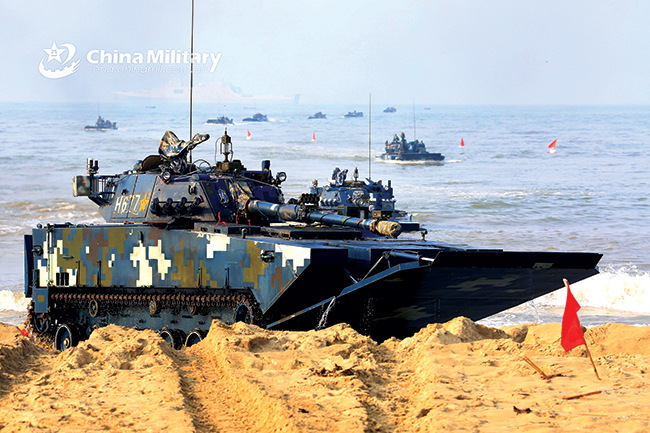
People’s Liberation Army Navy Marine Corps amphibious armored vehicles arrive at a beachhead 17 August 2019 during amphibious assault training in south China’s Guangdong Province. (Photo by Yan Jialuo and Yao Guanchen, Ministry of National Defense of the People’s Republic of China)
These apparent shortcomings should not be taken to mean that an invasion is beyond China’s capabilities but instead that the Chinese believe a 1944 D-Day-style invasion is unnecessary. Americans forget that their large Marine Corps is a unique force historically and that amphibious assaults predate the Marines.21 The Marines developed specific tactics and equipment prior to World War II to make large-scale forcible entry and sustained combat ashore their missions, an approach followed since World War II until the recent focus on integration with the Navy.22
China has a large source of sealift in the form of civilian vessels built with a reserve military role.23 Rather than traditional beach landings, China could seize ports using its special forces and some of its marines supported by the Chinese airborne group army and with follow-up civilian ships bringing in heavier forces. The Taiwanese army could be surprised in its barracks or beach defenses, unable to redeploy quickly and in good order under PLA missile and air attack while the Chinese airheads and bridgeheads are forming and most vulnerable to counterattack.24
China has experience with an amphibious campaign that diverges from American practice. Despite a lack of amphibious ships and trained personnel for its navy, the PLA successfully conquered Nationalist-held Hainan Island, which is only slightly smaller than Taiwan, in April 1950. The Chinese suffered heavy losses, but once ashore, captured over ninety thousand Nationalist troops. The landing was made possible despite superior Nationalist air and naval power by PLA artillery used to “gain effectual control of the sea and airspace between Hainan and the mainland.”25
Amphibious warfare is surely as difficult as the DOD states. But Hainan demonstrates that China can overcome the difficulties without using American methods.26 China can invade Taiwan if it can nullify air and naval power that could stop the crossing by the PLA. New Taiwanese emphasis on asymmetric approaches to fighting the PLA, as well as U.S. Navy concerns about PLA A2/AD capabilities, indicate that China has already, at least in part, nullified air and naval power obstacles to invasion.
If the issue is simply one of a China-Taiwan war, China has the air and naval superiority to gain control of the Taiwan Strait in order to invade Taiwan. In 2012, the Taiwanese carried out a military exercise anticipating a direct Chinese attack on Taipei via a “landing on the shores of the Tamshui River, which flows through the capital.”27 If China can then build up forces faster than Taiwan can mobilize and counterattack, even if America can get naval and air power over and around Taiwan before China can defeat Taiwan’s ground forces, what can be done to prevent PLA ground forces from remaining on Taiwan in a “frozen conflict” that it can heat up at a time of its choosing to complete the conquest?
The Tyrannies of Time and Distance
Discussions of the U.S.-Chinese military balance obscure the reality that China needs to defeat Taiwan to win. China only needs to delay American entry to be able to focus on defeating Taiwan. Can China achieve key objectives on Taiwan before America decides to intervene and before American (and allied) military forces are gathered and sent into battle?
China can impose a delay on American intervention by military deterrence and by using the time it takes American civilian leadership to decide to intervene. Samuel Huntington said of these two aspects of national security decision-making,
One [world] is international politics, the world of balance of power, wars and alliances, the subtle and brutal uses of force and diplomacy to influence the behavior of other states. The other world is domestic politics, the world of interest groups, political parties, social classes with their conflicting interests and goals.28
One aspect of slowing American reaction time is the balance of power altered by a quarter century of rapid Chinese military modernization. The 1996 Taiwan Strait Crisis helped spur China to “focus on building capabilities to counter U.S. forces” and to deter Taiwan from moving toward independence.29 Two American aircraft carriers are no longer an operationally effective force standing in China’s way. A larger and more sophisticated Chinese military requires America to reinforce forces in the western Pacific with forces based in America or even in other parts of the world to mass enough power to fight through the PLA A2/AD shield just to reach Taiwan.
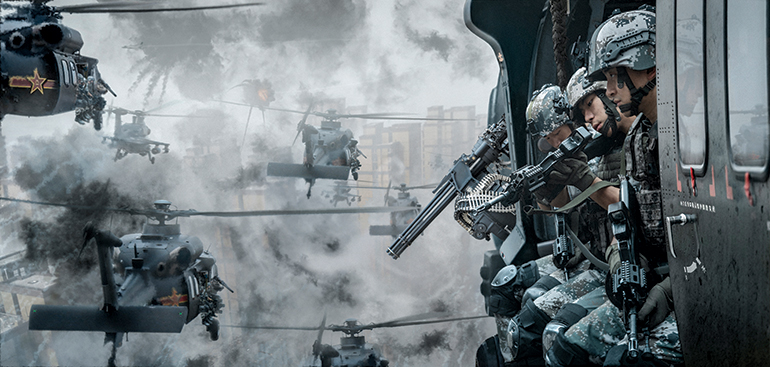
One of many pieces of nationalist propagandistic artwork created by students of the Sichuan Fine Arts Institute in Chongqing, China, that depicts various actions of a notional People’s Liberation Army invasion of Taiwan. (Image courtesy of the Sichuan Fine Arts Institute)
It is unlikely that China could carry out a “bolt from the blue” invasion; its preparation for an invasion could not remain hidden for long. But while a Soviet attack on West Germany would have immediately hit American forces, it would not be the case if China invaded Taiwan. If China refrains from striking American forces at sea, in Japan, or in Guam, American political leadership would be faced with the decision to fight a powerful China over a small and distant Taiwan. How quickly would America make that decision?
On three occasions when an enemy struck suddenly—in South Korea in 1950, in Kuwait in 1990, and after the 11 September 2001 al-Qaida terror attacks on the U.S. homeland—America’s decisions to react were rapid. In 1950, President Harry Truman ordered American air and naval action just two days after North Korea invaded.30 In 1990, President George H. W. Bush ordered American forces to Saudi Arabia less than a week after Iraq invaded Kuwait.31 And the U.S. Congress authorized military force a week after the terror attacks.32 China is a potential threat far larger than any of the enemies in those three examples, so the American debate could be longer, but China cannot count on a lengthy delay from America’s domestic politics.
American forces could be readied, sent to sea, and ordered to shift to the Pacific after identifying Chinese preparations consistent with invasion plans in advance of the political decision to fight.
The international relations power aspect is not simply the military balance of power that has shifted in China’s direction. The great physical distance that dominates American operations in the western Pacific requires time to overcome. Without American troops on the ground in Taiwan, there will be no automatic involvement on the first day as there would have been in West Germany during the Cold War. In the Korean War, despite a quick political decision to intervene and American forces in nearby Japan, the initial ground force was not on the ground until a week and a half after the North Korean invasion, with three more divisions reaching South Korea over three weeks after the invasion.33 In the 1990 Persian Gulf War, it took about six weeks to deploy the 24th Infantry Division (Mechanized) from the continental United States to Saudi Arabia—without Iraqi interference.34 In a direct attack on America in 2001, it took over five weeks before the first Special Forces were on the ground in out-of-the-way Afghanistan.35
Certainly, American forces could be readied, sent to sea, and ordered to shift to the Pacific after identifying Chinese preparations consistent with invasion plans in advance of the political decision to fight. Some Army units could be moved to Taiwan in weeks—assuming the Navy and Air Force can keep air and sea lines of communication secure. But American armored forces located in the continental United States are unlikely to outpace a PLA buildup across a one hundred-mile strait. Those armored forces are the key to defeating a Chinese invasion of Taiwan.
Staying Ashore
Landing an invasion force on Taiwan is not beyond the PLA’s capabilities and experience. American strategists must not conflate the prevention of China’s total conquest of Taiwan with defeating China. What if the key objectives China must attain in an invasion are simply those that allow China to sustain a military presence there rather than breaking out and occupying the island? Failure to drive the PLA ground forces into sea could be tantamount to losing Taiwan. At best, America might find itself manning a second, Korea-like demilitarized zone in INDOPACOM in defense of Taiwan. At worst, America could be confronted later with a choice to liberate Taiwan using a U.S. Marine Corps less focused on large-scale amphibious warfare against Chinese A2/AD assets emplaced on Taiwan.
China does not need to destroy the Taiwanese military, occupy all of Taiwan, or even capture Taipei to win the war. If China can move sufficient army groups onto Taiwan and maintain a reasonable line of supply, it can suspend the war at any time. Taiwan’s Overall Defense Concept’s (ODC) core premise is that Taiwanese asymmetric warfare capabilities will target Chinese weaknesses most efficiently “while surviving long enough for third-party intervention.”36 Much of the world—perhaps America especially—would be relieved to have a cease-fire before American and Chinese forces are openly shooting at each other. China would use that cease-fire to strengthen its position on Taiwan and prepare for a second phase of the invasion: the breakout and final conquest of Taiwan.
By the end of June 1944, despite damage to one artificial port and the destruction of the other, nearly a million Allied troops were ashore on the Normandy beachhead following the D-Day invasion of German-occupied France.37 The Germans missed their opportunity to throw the invaders into the sea and could not prevent an Allied buildup and subsequent drive into the heartland of Germany. Taiwan faces that dilemma if the PLA ground forces get ashore. The question is whether Taiwan can throw the invaders into the sea. While Taiwan’s new ODC focuses on asymmetric warfare capabilities, an approach “widely lauded by international experts,” once the Chinese are ashore, the Taiwanese will desperately want force-on-force symmetrical ground combat capabilities with a conventional arsenal, such as Abrams tanks that Taiwan has decided to purchase, but that does not conform to the ODC.38 Taiwan will need to deny China a pause to build up and resume the war months or years later.
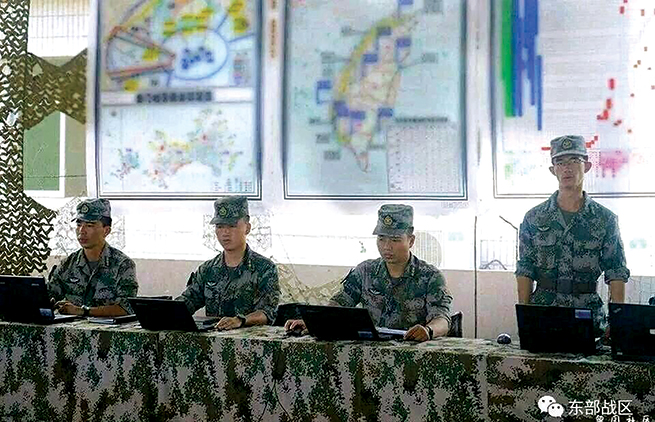
An image from Chinese social media depicts a People’s Liberation Army command post exercise with a topographic map of the southern coastline of Taiwan prominently featured. (Photo courtesy of ETtoday)
The Taiwanese will need to drive the PLA ground forces into the sea and not just contain the Chinese in their enclaves. Taiwan has 140,000 ground troops in three group armies totaling twenty-two combat brigades facing a potential invasion force of over 400,000 ground troops in seven army groups (including marines and airborne forces), totaling fifty combat brigades in the eastern and southern theaters (those closest to Taiwan).39 While the Taiwanese might be thinking of how many PLA troops the Taiwanese ground forces could prevent from driving on Taipei until America intervenes, the correct question is how many PLA troops China would need on Taiwan to stop a Taiwanese counterattack. Consider that even a successful mobilization of Taiwanese reserve troops simply provides hometown local defense forces while the active forces carry out the main combat missions.40 Is Taiwan's active army a "hollow shell" with shortages of personnel especially acute in combat units?41 Would even one hundred thousand PLA troops with ample air and naval support be enough to dig in and hold on against Taiwan alone?
Even a fully manned active Taiwanese army equipped for large-scale combat operations may be inadequate. If so, simply pushing Taiwan to spend more on defense and correcting manning deficiencies is not enough. Taiwan will need help from abroad. America is the only source of ground forces capable of conducting offensive large-scale combat operations. The Marine Corps has significant forces deployed in the western Pacific, but the Marines are getting lighter and focusing more of their attention on supporting the Navy in a sea control battle in the new era of great-power competition.
That leaves the U.S. Army to provide a corps of two-to-four divisions plus supporting units to spearhead offensives against the PLA bridgeheads.42 Naturally, this requires the Navy and Air Force to fight through China’s A2/AD-supported naval and air forces to gain secure access to Taiwan’s ports and airfields that would allow the deployment of the Army and provide joint U.S. forces opportunities to interdict China’s line of supply across the Taiwan Strait.
This scale of U.S. Army involvement in INDOPACOM outside of the Korean Peninsula is truly a new idea in the twenty-first century.43 The infrastructure and logistics support to carry it out are insufficient. A proposal patterned on spending to improve logistics capabilities in NATO could broaden INDOPACOM’s reach.
Under the multiyear INDOPACOM proposal, $5.8 billion would be for offensive missiles and multiple radars, including a space-based radar; another $5.8 billion would be used to distribute forces around the region; and $5.1 billion would be for “logistics and security enablers”—a broad array that includes counterpropaganda operations, fuel storage, battle-damage repair facilities, as well as military aid for forces in Indonesia, Malaysia, the Philippines, Thailand, and Vietnam.44
This is just a first step in enabling the Army to decisively intervene to prevent China from beginning the conquest of Taiwan. If afloat Army prepositioned stocks for heavy divisions are needed in the western Pacific to speed their deployment, they should be added to the proposal.
Victory
Taiwan is a location around China’s periphery where the Army’s core competency of large-scale combat operations could potentially be carried out for a decisive outcome. Counting on a Taiwanese ODC asymmetric strategy of inflicting casualties to deter China from invading is risky. Years ago, it seemed as if there was a limit to what China would endure to take Taiwan:
Some months ago it was reported that the Chinese high command regularly provides the leadership with its predictions for an attack against Taiwan. Apparently in 2004 it emerged under questioning that about 21,000 deaths were expected in such an attack. Contrary to Western views that China has unlimited manpower and that human life is cheap, the leadership found this figure unacceptable.45
The problem is that a casualty-inflicting deterrence strategy relies on the enemy tolerance for deaths. We cannot know when the Chinese will see an improving—or fleeting—military situation that brings the anticipated death toll within an acceptable range. And we cannot know when the domestic situation will make Chinese Communist Party (CCP) rulers far more tolerant of military casualties. The Chinese military exists to keep the CCP in power.46 If the CCP needs to conquer Taiwan to remain in power, PLA casualties may not be a limiting factor.
Once the PLA is ashore, the missions to defeat the invasion will be to contain and isolate the bridgeheads; prevent them from consolidating; slow the PLA buildup; and enable a Taiwanese counterattack as soon as possible before the PLA ground forces bring in heavy weapons and supplies to fight a major battle. These missions can be promoted by
selling Taiwan the heavy armor, attack helicopters, and fires and support assets needed to defeat the PLA in large-scale combat operations;
sending U.S. Army fires, aviation, air and missile defense, and other supporting units to Taiwan (in addition to Navy, Marine Corps, and Air Force assets) to support a Taiwanese counteroffensive; and
dispatching an Army heavy corps to Taiwan.
The latter step will bolster Taiwanese morale with the knowledge that maneuver unit reinforcements are coming and will provide the core for a decisive counterattack if Taiwan’s maneuver brigades alone are unable to drive the PLA ground forces into the sea.
The idea that Taiwan must be able to resist the PLA until America intervenes is not without merit. The question is, what does America do when its forces arrive? Arriving in time to enforce a cease-fire is simply a means to delay losing. Just the credible threat of a U.S. Army corps capable of deployment to Taiwan might deter China from starting an invasion; China might no longer be confident that the main effort will remain one between the PLA and the Taiwanese ground forces. And if deterrence fails, the corps will drive the enemy into the sea.
No comments:
Post a Comment